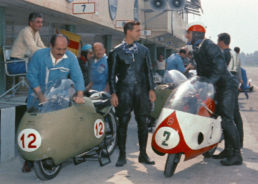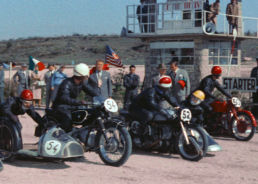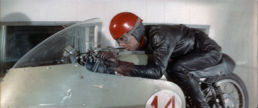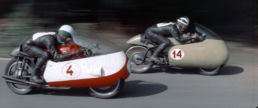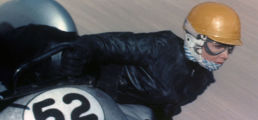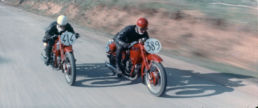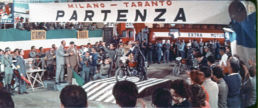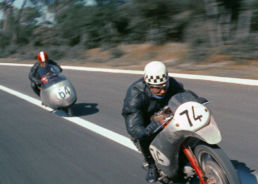
A gripping tale of speed, challenges and betrayals, shot during real races and starring most of the biggest race champions of the ‘50s. A legendary film, thought lost for 60 years and finally recovered and restored thanks to the support of motorcycle lovers from all over the world.
A couple of years before his greatest success with “La Grande Olimpiade” (The Grand Olympics), Oscar nominee for best documentary in 1961, Romolo Marcellini directed “I fidanzati della morte” (Engaged to Death). A fiction film, this time.
A tale about rivalry and burning passion set into the celebrated world of motorcycle races. A fictional story, but set and shot during real races: the most important motorcycle competitions, such as the legendary Milano-Taranto race and Monza’s Moto GP, just before Guzzi, Gilera e Mundial retired from speed racing. The film also features rare footage of the Guzzi wind gallery and of the Moto Guzzi factory in Mandello del Lario. “I have been dreaming to direct ‘I fidanzati della morte’ for many years, and finally I made it. (…) With this film I wanted to honor motorcycling and motorcycle sports, and to stick to reality in representing a competition world that is in fact exciting in itself.” And he pursued his goal to the point that he managed to involve many of the greatest champions of the ‘50s: Geoff Duke, Libero Liberati, Bill Lomas, Enrico Lorenzetti, Reg Armstrong, Stanley Woods, Dickie Dale, Ken Kavanagh, Bruno Francisci, Pierre Monneret, Walter Zeller, Thomas Campell, Albino Milani.
In spite of its international distribution and cast (also guest starring along Sylva Koscina and Rik Battaglia is Hans Albers in his last appearance, Gustavo Rojo and Margit Nünke), after 1957 the film disappeared for almost 60 years. However, it lingered in the memory, and continued tickling the imagination of several generations of motorcycle lovers.
Now, Rodaggio Film is able to ‘revamp’ the film after its restoration, thanks to a crowdfunding project, and to thousands of supporters and donors from 22 different countries .
Rodaggio Film also involved testimonials such as Giacomo Agostini, Paul d’Orleans, Roberto Totti, Melissa Holbrook Pierson, Paolo Sormani, Livio Lodi, Roberto Parodi, and worked in partnership with the Italian Motorcycle Federation (FIM) and many motorclubs from all over the world.
What is it that still makes this film so peculiar? 1957 represented a turning point in the history of two wheels: the leading motorcycle manufacturers – Guzzi, Gilera and Mundial – at the very peak of their international success and innovation process decided to retire their teams from international competitions. Moreover, following a tragic accident during the Mille Miglia race, the extremely popular road races were banned: Marcellini was in fact able to film the last epic edition of the Milano-Taranto race, a competition as dangerous as symbolic for its ability to reunite the North and the South of Italy with just gasoline and modernity.
The magnificent (and unmanageable) dubstin fairings, too, were soon after banned by FIM, in 1958.
“I fidanzati della morte”, a colored Cinemascope film, captures both a unique moment in the history of the Italian motorcycle industry and the swan song of historic motorcycling. Had he filmed it two years after, or before, it wouldn’t have the same value.
After 60 years, the film is now available once more in an elegant collector’s edition enriched by Lorenzo Eroticolor’s original illustrations. Inside it, the DVD with subtitles in 5 languages, special contents (among which the interview with the nine-times world champion Carlo Ubbiali) and a booklet with contributions written by Luigi Rivola, Giulio Gori, Paolo Sormani and Arturo Rizzoli.
Plot:
After a disagreement with the technical engineering director, Mr. Angelini, the successful race pilot Carlo Benni (Rik Battaglia), leaves the “Zetavu” motorcycle manufacturer (which closely resembles Guzzi, a very successful brand at that time) and starts to work with his father-in-law Lorenzo, frontman of the little but promising brand “Fulgor”.
Carlo becomes infatuated with Lucia (Sylva Koscina), the daughter of his previous boss, and his passion leads him to leave his wife, a former star of the wall of death, and his father-in-law. However, the relation soon comes to an end, shortly before the Milano-Taranto race. After a dreadful accident on the last mile, Benni not only loses the most important race of that time, but also gets disqualified.
In Germany, where he retires to ride in dirt track races, he is joined by his wife, who also becomes his sidecar companion for a race. Thanks to this victory, Benni is able to redeem the “Freccia” (meaning “arrow”), an innovative motorcycle with a direct injection engine, built by his father-in-law Lorenzo to race at Monza’s competition. Here, Benni faces his rival Mr. Angelini, former pilot, who rides a similar – but not yet fine-tuned – prototype. Danger awaits him on the legendary Parabolic Curve, known at that time as Porphyry Curve…
I FIDANZATI DELLA MORTE – ENGAGED TO DEATH
CreditsItaly, 1957, 88 min
Directed by: Romolo Marcellini
Cast: Rick Battaglia, Sylva Koscina, Margit Nunke, Carlo Ninchi, Saro Urzì, Gustavo Rojo, Hans Albers
Produced by: GIUSEPPE DRIUSSI (SIRIO FILM - Rome), NEO FILM UND WERBURG (Germany)


